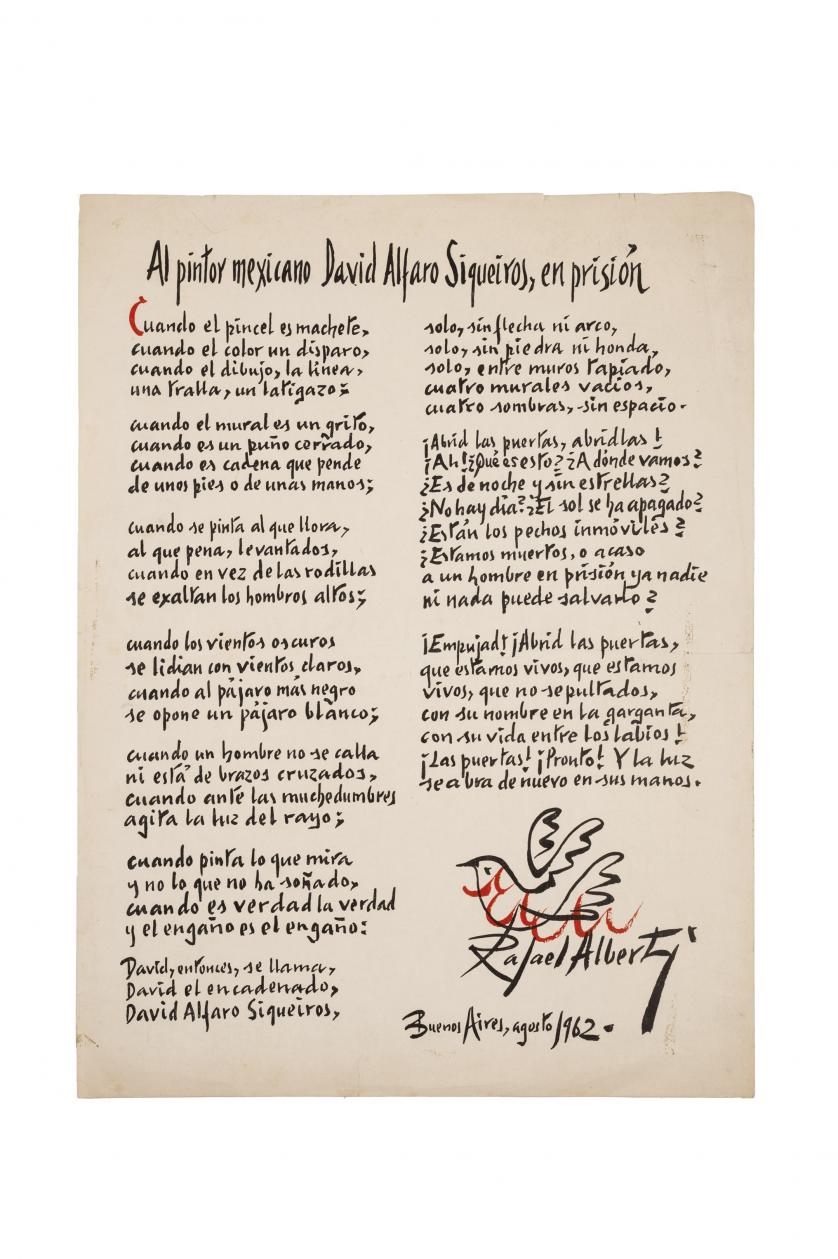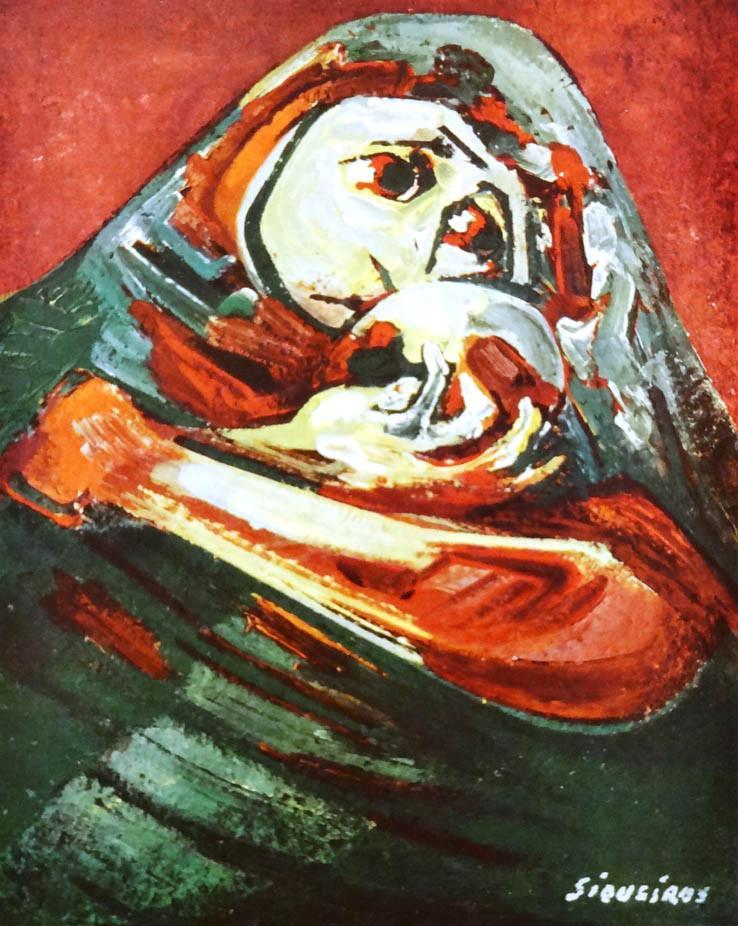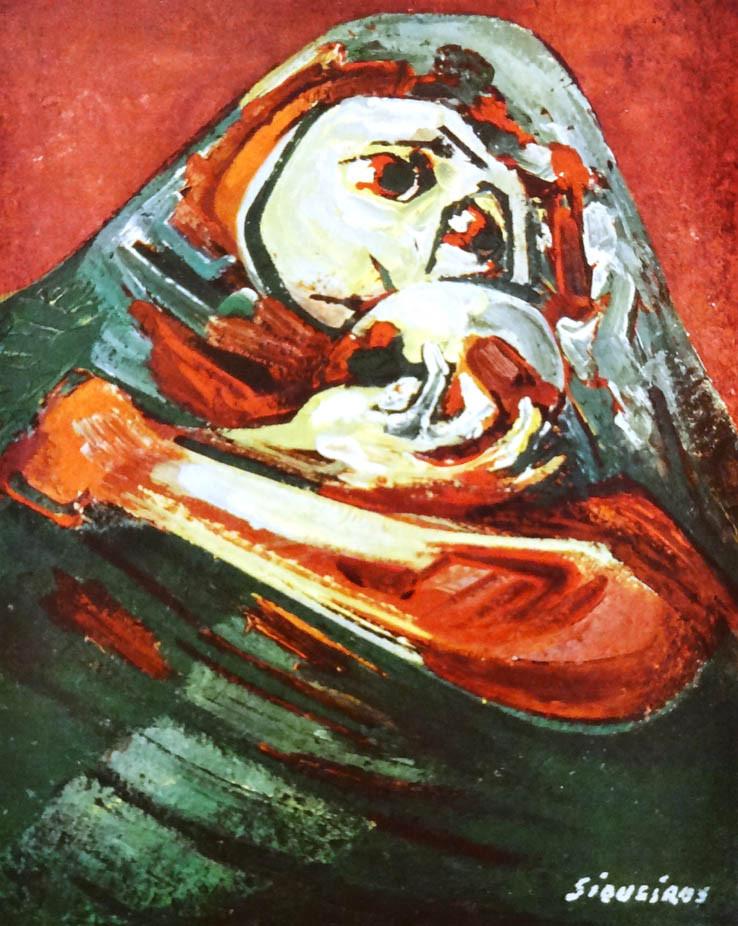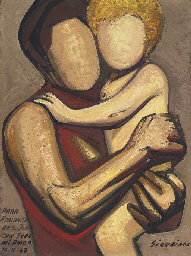David Alfaro Siqueiros Explosión en la ciudad 1935 pyroxylin on canvas 16 7/8 x 19 1/4 in. (43 x 49 cm) Signed "Siqueiros" lower right; further signed, inscribed and dated "Este cuadro lo pinté yo en 1935 Siqueiros Mex 3/5/70" on the reverse.
Provenance Park-Bernet Galleries, New York Galería Feldman, Buenos Aires Christie's, New York, Important Latin American Paintings, Drawings and Sculptures, Part II, November 21, 1995, lot 150 Private Collection, Texas Catalogue Essay The image of the city in front of our eyes is both a starting point and an end point. It is an aerial perspective. We watch a cloud of smoke rise from the charred remains of a tiny city in the middle of the desert. This painting, which is almost definitively a study for the famous painting identically titled to the present lot, Explosión en la Ciudad [Explosion in the City] (Collection of the Museo Carrillo Gil), explores the phantasmagoric possibilities of the fanciful forms of clouds of fire and smoke. In the present lot, "the plastic uproar" that forms the base of the composition of this small, yet monumental painting is the result of modeling silicate paint, traditionally used to coat automobiles, on the canvas as if it were play dough. In 1932 in Los Angeles, Siqueiros had already begun to investigate the use of coloring materials that would be appropriate for painting exterior walls. In Buenos Aires in 1933, Siqueiros learned about a type of industrial paint that Keim, a German company, had recently introduced in the market, which he would go on to utilize for his mural Ejercicio Plástico [Plastic Exercise], painted that same year. It is highly probable that when Siqueiros returned to New York in 1934 he would have known about pyroxylin made by Dupont as well. In other words, by 1935 Siqueiros was already well versed in the types of materials he used to execute this painting. This painting, as well as the painting at the Museo Carrillo Gil, comes from a period of sparse artistic production in Siqueiros’s career, and the two works turn out to represent a kind of missing link. They demonstrate how Siqueiros went from the abstract modeling of "real" clouds, in these two cases, to the types of "controlled accidents" he created in his Experimental Workshop in New York. Beginning with Nacimiento del Fascismo [The Birth of Fascism] in 1936, Siqueiros created paintings from the Experimental Workshop period by spraying streams of paint from cans of paint at random onto supports placed on the floor, which he would later superimpose with figurative designs. The present lot was one of Siqueiros’s first experimentations in a sculptural handling of coloring materials. As this work was painted on canvas rather than wood, we are led to believe it is a study for the larger painting in the collection of the Museo Carrillo Gil. The present lot depicts a sinister black cloud that detaches itself from a city in flames, constructed like a plastering of bright black, red, white and yellow industrial paint - the infinite horizon is marked by a blue diagonal line on the right side - on gray and brown backgrounds. This 1935 study is one of the first attempts by Siqueiros to not only transmit the appearance of the explosion, but also the sensation of its form. The almost identical appearance of the present lot to the sculpted painting Explosión en la Ciudad at the Museo Carrillo Gil gives us ample reason to believe that both were painted in 1935. This adds to the importance of the present lot as it refutes the argument of researcher Esther Acevedo that the larger painting was executed in 1945 and therefore depicted the atomic bomb. Siqueiros would however go on to paint the atomic mushroom cloud in his 1955 painting, Hiroshima. Explosiveness and monstrosity are two significant themes in the work of the artist from the 1930s onwards. These paintings represent the artist’s forebodings of war before he enlisted as a soldier in the army of the Spanish Republic in 1937-38. The shape of the burning cloud in this impressive small painting is the result of a calligraphy of concentric circles that cross space in a threatening manner and culminate in a diagonal in the upper right hand corner. The circles are craters that leave
David Alfaro Siqueiros Explosión en la ciudad 1935 pyroxylin on canvas 16 7/8 x 19 1/4 in. (43 x 49 cm) Signed "Siqueiros" lower right; further signed, inscribed and dated "Este cuadro lo pinté yo en 1935 Siqueiros Mex 3/5/70" on the reverse.
Provenance Park-Bernet Galleries, New York Galería Feldman, Buenos Aires Christie's, New York, Important Latin American Paintings, Drawings and Sculptures, Part II, November 21, 1995, lot 150 Private Collection, Texas Catalogue Essay The image of the city in front of our eyes is both a starting point and an end point. It is an aerial perspective. We watch a cloud of smoke rise from the charred remains of a tiny city in the middle of the desert. This painting, which is almost definitively a study for the famous painting identically titled to the present lot, Explosión en la Ciudad [Explosion in the City] (Collection of the Museo Carrillo Gil), explores the phantasmagoric possibilities of the fanciful forms of clouds of fire and smoke. In the present lot, "the plastic uproar" that forms the base of the composition of this small, yet monumental painting is the result of modeling silicate paint, traditionally used to coat automobiles, on the canvas as if it were play dough. In 1932 in Los Angeles, Siqueiros had already begun to investigate the use of coloring materials that would be appropriate for painting exterior walls. In Buenos Aires in 1933, Siqueiros learned about a type of industrial paint that Keim, a German company, had recently introduced in the market, which he would go on to utilize for his mural Ejercicio Plástico [Plastic Exercise], painted that same year. It is highly probable that when Siqueiros returned to New York in 1934 he would have known about pyroxylin made by Dupont as well. In other words, by 1935 Siqueiros was already well versed in the types of materials he used to execute this painting. This painting, as well as the painting at the Museo Carrillo Gil, comes from a period of sparse artistic production in Siqueiros’s career, and the two works turn out to represent a kind of missing link. They demonstrate how Siqueiros went from the abstract modeling of "real" clouds, in these two cases, to the types of "controlled accidents" he created in his Experimental Workshop in New York. Beginning with Nacimiento del Fascismo [The Birth of Fascism] in 1936, Siqueiros created paintings from the Experimental Workshop period by spraying streams of paint from cans of paint at random onto supports placed on the floor, which he would later superimpose with figurative designs. The present lot was one of Siqueiros’s first experimentations in a sculptural handling of coloring materials. As this work was painted on canvas rather than wood, we are led to believe it is a study for the larger painting in the collection of the Museo Carrillo Gil. The present lot depicts a sinister black cloud that detaches itself from a city in flames, constructed like a plastering of bright black, red, white and yellow industrial paint - the infinite horizon is marked by a blue diagonal line on the right side - on gray and brown backgrounds. This 1935 study is one of the first attempts by Siqueiros to not only transmit the appearance of the explosion, but also the sensation of its form. The almost identical appearance of the present lot to the sculpted painting Explosión en la Ciudad at the Museo Carrillo Gil gives us ample reason to believe that both were painted in 1935. This adds to the importance of the present lot as it refutes the argument of researcher Esther Acevedo that the larger painting was executed in 1945 and therefore depicted the atomic bomb. Siqueiros would however go on to paint the atomic mushroom cloud in his 1955 painting, Hiroshima. Explosiveness and monstrosity are two significant themes in the work of the artist from the 1930s onwards. These paintings represent the artist’s forebodings of war before he enlisted as a soldier in the army of the Spanish Republic in 1937-38. The shape of the burning cloud in this impressive small painting is the result of a calligraphy of concentric circles that cross space in a threatening manner and culminate in a diagonal in the upper right hand corner. The circles are craters that leave











.jpg)
.jpg)


Testen Sie LotSearch und seine Premium-Features 7 Tage - ohne Kosten!
Lassen Sie sich automatisch über neue Objekte in kommenden Auktionen benachrichtigen.
Suchauftrag anlegen